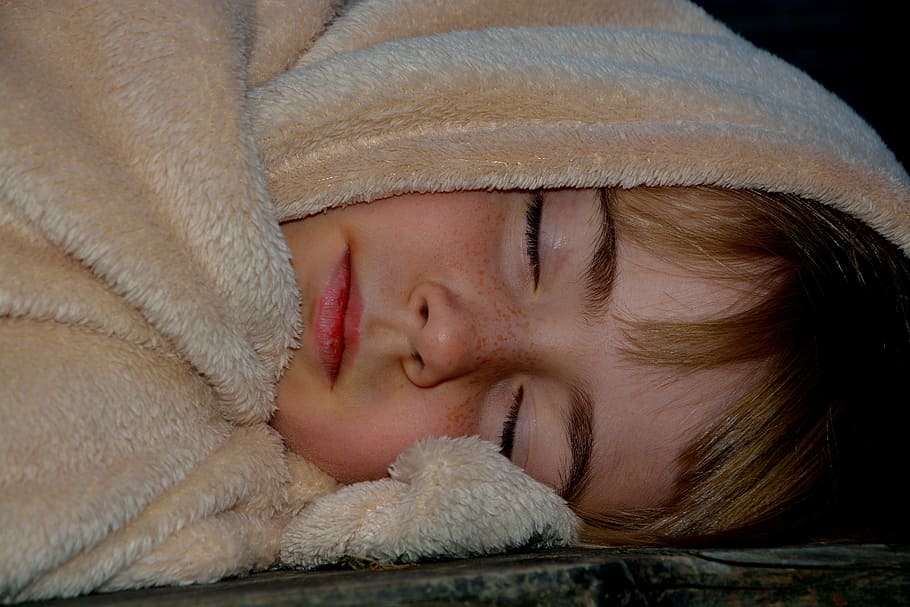How to keep toddlers warm at night? This is a guide for young parents who fear their babies will be too cold during the nights. We will go over a few tips and advice. Keep reading.
At night, if adults feel a nip in the air, they can pull on duvets or blankets. However, things are different with kids.
They are almost always clueless about the weather conditions, and you can’t make them keep their blankies on at night.
If you had a dollar for every time your kid kicked off the blanket and ended up in your bed, you’d be a millionaire by now, right? So how do you keep them warm at night? We are going to tell you how to keep toddlers warm at night!
How To Keep Toddlers Warm At Night

Toddlers are a lot of hard work. Whether you’re a parent or a babysitter, you know how you always have to put in some extra to ensure that a toddler is safe and healthy.
After all, they are quite vulnerable. So, it’s your job to protect them, even at night when they are sleeping.
One of the things that they need protection against is the cold. You need to ensure that the baby is warm, especially at night.
Being warm at night will not only keep away fever and illness but help the kid to get a sound sleep at night and wake up well-rested and happy.
To ensure that a child is warm and safe at night, here’s what you can do:
1. Heating Accessories for the Bedroom
To keep a toddler warm at night, start by controlling the temperature of the bedroom. Consider investing in a high-quality heating system that can work for the whole house.
This will ensure that the child doesn’t face a sudden drop in temperature when they leave the bedroom.
But a heating system for the entire house may be a little expensive. Nor is it always practical.
So, you can go for other alternatives just for the child’s room, like panel heaters, electric heaters, or oil heaters.
These are affordable, easy to control, and cost-effective solutions.
Choose one with a programmable timer that gives you control of the temperature.
According to WHO, your home should be at a minimum temperature of 20C if there are young children there.
Also, make sure that the heater has a thermostat so that you can monitor the temperature easily.
2. Warm Nightwear
Onesies are a practical way to keep toddlers warm at night. The kid cannot throw or kick it off. Besides, onesies eliminate socks from the night scene.
Socks might go missing in the middle of the night – but you won’t have to worry anymore. Plus, kids look so cute in footed jammies!
If your toddler makes toilet runs at night, onesies can be a problem. In that case, pick warm flannel PJs that have long sleeves and legs with cuffs that don’t ride up.
Remember to get vests or singlets to wear beneath the PJs. Don’t forget warm socks, mittens, caps, and thermal underwear, either.
Another fun way to ensure that a toddler is warm at night is a sleeping bag. These are not bulky ones for hiking.
These are tick and cottony sacks and are a fun way to encourage kids to stay warm. The designs and themes will even get them feeling excited about nap time!
3. Bedding Layers
Lining the bed with layers and covers can be a great way to deal with cold, especially on unpredictable nights.
Woolen mattress toppers or underlays and polar fleece sheets can keep the bed warm through the night. They are also really soft and comfy.
While covers are not always practical for children, you still need to make provisions to add them to the bed.
Line, the bottom of the bed with a blanket folded like a paper fan beneath the kid’s feet so they can pull it.
Another product that can keep a toddler warm at night is an electric blanket.
If you don’t believe that your kid will pull the blanket over when it’s and are sure that the cold will persist through the night, tuck the blankets on the two sides.
To ensure that they don’t slip off (read, get kicked off), place strapped grips beneath the mattress, so they keep the blanket in place.
4. Keeping The Chill Away
There are other simple ways to keep the cold out. One of them is the thermal curtain.
Install them on doors and windows to prevent the cold from seeping into the room through gaps.
To keep the floor warm, you should always place a thick carpet or mat on the floor. These can make a huge difference.
Besides carpets or mats on the floor, there are other ways to improve the insulation of the room.
You can add thick padding to the cold walls to ensure that they don’t bring down the temperature of the room.
You should also keep the windows and doors closed and seal the room properly.
Another really easy way to prevent the cold from touching your child in bed is a hot water bag or hand warmer.
Just pop it under the layers before bedtime and let it warm up the bed. Don’t forget to cover it before you place it in the bed, and remember to remove the bag before it starts to get cold.
How To Keep Toddlers Warm During Sleepovers

When you have one kid at home, it’s likely you’ll have more of them for sleepovers.
How do you ensure that the kids in the house are all warm and cozy, without losing out on any of the nighttime fun? But you create an exciting setting for them to enjoy a cold night and stay warm.
The first thing to do is to speak to the parents of the kids coming over and ask for warm PJs, caps, socks, or anything that they think might protect their children.
This applies to any babysitting situation. Make sure to organize the sleepover in the warmest room of the house.
a) Tents or Blanket Forts
To keep kids together and warm, you can always kick up a tent inside the room. You can also build a blanket fort.
You can even involve the kids in this activity and have fun while setting up something warm and cozy.
Inside the tent or blanket fort, body heat will be trapped while they play or sleep.
b) Double Layer of Blankets
When it’s bedtime, cover each kid with one blanket, and then add a large blanket on the top.
The two layers of blankets will keep them warm and happy. You probably already have single blankets.
If you don’t, you can arrange for the kids to bring their own blankies while you provide a large fleece.
c) Sleeping Bags
Most kids in cold regions have sleeping bags.
The cute ones are particularly meant for indoor use and are perfect for sleepovers, whether it is in your own home or if your little one is going over to your grandparents for a sleepover with cousins.
You can add a layer of warmth with sleeping bag liners.
d) Sleeping Pad
Whether the kids sleep inside a pop-up tent or in sleeping bags, you must make sure that it’s not directly on the floor. Place a sleeping pad on the floor to keep the cold at bay.
Make sure that it’s at least one inch thick. There are insulated sleeping pads available. Make sure to use a large one.
How To Keep A Sleeping Toddler Warm While Traveling

One of the best ways to keep sleeping babies warm and comfortable while traveling is by layering the baby with warm clothes and accessories. These are easy to carry around for you.
Besides, the baby will be wearing them most of the time, so it’s going to be hassle-free for you.
While traveling in a car or petting your toddler in a car seat, avoid thick jackets.
Instead, put a layer of a blanket on top. Small, lightweight blankets for toddlers should fit into your travel bag and provide an extra protective layer. You should also put a cover on the car seat to keep the baby warm.
For the bed in the hotel room, use a hot water bag that can be carried from home, too.
However, if you’re planning to go camping or hiking with a toddler, sleeping bags with liners (designed for outdoor use) and sleeping pads (preferably thermal) are a must-have.
If you have a large tent, you can use a foldable sleeping bed for toddlers.
These days, you can also find carry-cots that double as strollers and car seats so that your toddler can lie in an elevated bed space even when in the tent, especially in cold regions or during winter months.
Tips for Keeping Toddlers Warm at Night
You now have a brief idea that in order to keep toddlers warm at night, you need many accessories.
Feeling overwhelmed? Don’t be. Here is a list of all the things that you need to do in order to keep toddlers warm and cozy so that they don’t end up with a cold:
- Apply a baby cream to prevent your kid from waking up due to dryness or itchiness.
- Use easy-to-remove layers of warm vests, thermal underwear, PJs, socks, mittens, and caps.
- Invest in a good fleece or thermal blanket and keep them in place using grips with straps.
- Adding extra layers of blankets or covers will help to remove them as and when required.
- If your toddler hates blankets and duvets, a warm onesie or sleeping sack can be an option.
- Add layers of warm sheets, covers, and more to the bed to keep the mattress warm.
- Use carpets, thermal curtains, and a heating system to maintain 20 C or higher.
- Keeping the outward-facing windows closed is essential, but the room must be ventilated.
- Moving the child’s bed to the warmest room, especially in winter, is a good idea.
It is essential to keep your baby warm and cozy at night. However, you have to be careful not to suffocate the child, and the body temperature must be maintained.
Too many layers can become fatal and lead to SIDS or Sudden Infant Death Syndrome.
Safety Tips While Keeping A Toddler Warm At Night
Attempting to keep a toddler warm at night is not enough. You have to ensure that the child is also comfortable.
You have to make sure that they are safe, too. So here are a few precautions you need to take to keep a toddler safe and warm at night and prevent risks of SIDS –
- Don’t overheat the room or place too many layers on the child. Overheating is one of the primary causes of SIDS.
- Putting too many covers or wrapping the baby can lead to breathing problems. Try to keep the mouth, nose, and neck free.
- Avoid using heavy blankets. Toddlers will not be able to push off the blanket on their own and feel suffocated and uncomfortable.
- Don’t keep the baby wrapped or layered all the time. Keep them handy and put the layers on only when it’s cold.
- Make sure to use a space heater in your kid’s room, which is safe. It might lead to carbon monoxide poisoning or fire burns.
- Don’t use soft and lightweight mattresses, as they have cold air trapped inside. This air can make your little one ill.
- Keep an eye out for signs like a sweaty nape and flushed cheeks to know when to remove a few layers of clothes.
It is crucial to ensure that your child is comfortable while warm. We are not talking about fussy kids who hate blankets and warm clothes and hats, even when it is cold.
You have to monitor the baby constantly. Touch the nape for signs of sweat and check if the child’s cheeks are flushed.
Importance Of Keeping The Toddler Warm
As long as you have had a baby or started babysitting, you must have heard that it is crucial to keep a toddler warm.
You probably already know and follow a few basic steps of keeping them safe from the cold, especially during winter. But have you ever wondered why it is important?
As a parent, guardian, or babysitter, it becomes your responsibility to ensure that the child is not cold, as toddlers are hardly capable of figuring out when it is chilly all around, or if they are feeling cold.
This is particularly true for their hours of sleep when they throw away blankets and lose socks.
As a parent, you are responsible for keeping your children warm for at least the first seven years of their lives.
You’ll be surprised to know that they don’t feel cold because of their high rate of metabolism, which always keeps them warm. So you will hardly ever hear a child complain about being cold.
But it is beyond their inability to understand what is good for them. Children are incapable of adjusting their body temperature like adults.
In the face of low temperatures, they aren’t physically equipped to deal with it. You’ll know they’re cold when their palms, ears, nose, or fingers turn cold.
You have to remember that toddlers are vulnerable little beings, and the winter chill impacts them heavily.
It is true that they have better blood circulation than children, which is why they are not susceptible to certain cold-induced conditions like a heart attack. But the cold can still make them ill.
This is because their immune system is relatively weak, and they can catch infections quite easily.
That is why they end up with fever, influenza, cough and cold, and other ailments easily. Also, if their body temperature drops, they can develop autoimmune deficiencies.
While it’s true that toddlers can regulate body temperature, it is also true that their bodies use the potential energy of “growth” to keep them feeling warm until they are about to get hypothermia.
Now, this energy should ideally be used for the development of the body and fend off infections.
To ensure that this energy gets used by a toddler’s body for growth and strengthening of the immune system, keeping the little one warm is essential.
You have to dress your child in layers and take all necessary precautions to keep them warm and comfortable.
As a parent, you are also responsible for helping your child become more aware of cold conditions and gain a sense of warmth.
This will help to strengthen their immune system and develop healthy organs and muscles. You must ignore your ever-excited toddler’s pleas to stay in the cold.
Conclusion:
You must remember that toddlers are not aware when their body gets cold. They also fail to communicate when they are uncomfortable because they can’t really put their teeny fingers on the problems – or put their problems into words to tell you they want a blanket.
On top of that, their metabolism rate is high, and they are always super-active. So, it is upon you to understand when they are cold and cover them up.
This is particularly true at night. The best way to ensure that your toddler is warm at night is with the help of layers.
Be it clothes and accessories or blankets and covers – layers are safe as you can remove them one after the other if a child feels too warm.
Other options to warm the toddler’s bed and room are also there. But you must also ensure that the baby is not too warm, as overheating can be hazardous.

